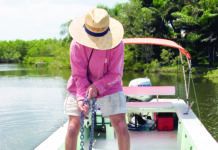Womanship
Following our August 15, 1999 report on sailing schools, we received numerous letters from readers concerning Womanship. Many supported our conclusion that Womanship needs to rethink its basic policies before continuing as a credible sailing school for women. In addition, we received many letters from women who had positive experiences aboard Gusto, which received less than a positive assessment in our report. Representative letters concerning Gusto follow.
My daughter and I went to Key West in spring 1998 and did the three-day live-aboard on the ketch Gusto. Gusto was by no means bustod as described in your article. Gusto was in great shape and sailed well in 10- to 25-knot winds 5 miles offshore. Shes a heavy, bluewater boat and excellent to learn on.
The same woman who called Gusto a sloop thought she was being made a fool of to help rescue a sinking outboard? I wouldve done the same thing for a fellow sailor, and certainly for my OWN boat (or chartered one), which is the point of the whole thing, isn’t it? To learn how to handle ANY situation? I would come away from such an experience thinking it was good training for the unexpected.
My daughter and I had a good experience aboard Gusto. Her captain cooked a delicious gourmet dinner for us the first evening aboard, then we rotated turns at the galley as we expected from the course literature.
We were not all of similar ability. However, this was not a problem. We were given lots of individual instruction as well as group lectures. I considered the trip well worth the cost.
The Womanship School is indeed less structured as mentioned in the article, and this may bother the student who wants to have an agenda, a lesson book, etc. The school might benefit by advertising their instruction as such. However, I would be willing to bet there are far more satisfied students than unsatisfied.
Susan Reaves
Cornelius, North Carolina
I had a wonderful time aboard Gusto! Learned quite a bit and enjoyed myself at the same time. The two who did not want to help save the life boat might be better suited to day spas than sailing schools!
Ashley Joyner
Cornelius, North Carolina
My husband and I took a Partnership course on Gusto last March and found her skipper to be an excellent teacher, thoroughly knowledgeable, patient, mature and very conscientious about her work. There was initially some miscommunication about our goals (which came from Womanship, not from the skipper or us). After we clarified our goals, the week was an excellent learning experience. We would both regret it if for whatever reason she did not continue to teach.
Annie Elliott
via e-mail
Catalina 42
How could you compare the Catalina 42 to a Chevrolet (July 1, 1999)? Even the owner of a one-off knows his boat has more personality than a Chevrolet.
In Practical Sailors drive to present factual, unbiased, autopsy-like boat reviews, it missed the heart and soul of a truly exceptional sailboat that continues in production after 11 years. In the past youve shown more enthusiasm for antifouling bottom paint than for this comfortable sailer that can take your breath away! The Catalina 42s beauty is obvious in those North Sails ads that appeared in Cruising World and Sail.
Furthermore, your writer failed to even hint at the heart stopping experience of viewing the master stateroom and head-shower suite that does away with the ho-hum V-berth. Over the past 10 years, hundreds of friends and casual visitors have gasped with pleasure when they looked into my Z-Life.
Finally, who cannot feel truly alive in that spacious cockpit and walk- through transom that allows you to hop into your dinghy or into the water easily and often. Wake up! Stop smelling the formaldehyde. Seeing and sailing the Catalina 42 can be a vitalizing experience that everyone should try.
As a subscriber to Practical Sailor since 1981 I appreciate your efforts to lead your readers to the facts. It is gratifying that your examination unearthed no serious physical disorder and uncovered the basic honesty of the design and its construction. It might surprise you, and run contrary to your editorial goals, that cold facts may fail to tell the essential story.
Bob Zoller,
Commodore, C-42 International Assn.
via e-mail
Bulwagga Anchor
Contrary to comments made by West Marines Chuck Hawley in the August 1, 1999 issue of Practical Sailor, the third fluke of the Bulwagga Anchor DOES NOT act like the unburied fluke of a Northhill or Yachtsmans anchor. These two anchors do invite fouling when set, because they present an exposed vertical post for the anchor line to wrap around. On the other hand, an appropriate setting load applied to The Bull will likely bury the anchor completely, third fluke included. If, however, the third fluke does remain partially exposed, it presents a triangle with 45 sloping sides to the anchor line, which will then glide up and over the fluke, returning the load to the shank. The third fluke HAS NEVER FOULED in extensive testing with a tow boat, in my own use, nor have any instances been reported by customers.
Because of the radial 3-fluke design, storage in a locker may not be feasible. However, when located at the bow ready to deploy, it stows conveniently on a bow roller, on bow rails, or with a simple modification on a platform roller.
I look forward to the results of your future anchor tests, especially in grass and weeds, for which the Bulwagga was specifically designed.
Peter Mele
NoTeco, Inc.
Crown Point, New York
CO2
Regarding Sam Trickeys question about carrying CO2 canisters aboard airplanes (August 15, 1999), I just flew twice with two inflatable PFDs. First, I was on United, and no one even noticed (or at least questioned) their presence in my carry-on. As a result, I forgot I had them in my bags. Then I flew from Phoenix to LAX on Southwest, and they were questioned at the security checkpoint. When I explained they were CO2, the inspection person said no problem with CO2.
Robert Wadsworth
via e-mail
I spend a good part of my time answering Chemical Safety and Hazardous Materials Shipping questions. Carbon dioxide in a cylinder is classified as a Dangerous Good under the International Air Transportation Association (IATA) because it is an asphyxiant in enclosed conditions (as is the case on an airplane). According to the 1999 IATA Dangerous Goods Regulations, CO2 is a hazard class 2.2 (non-flammable gas), packaging instruction 200, with a maximum quantity per package of 75 kilograms, which when shipped by commercial aircraft must be packaged, labeled, and properly documented for transport as required by law. Because West Marine will use commercial transport when shipping the PFD with CO2 canister, they are required to comply with the Hazardous Materials Transport regs.
Since Mr. Trickey is a private citizen transporting dangerous goods for personal use-the CO2-activated PFD-the IATA regs have exceptions for each instance. There is no reason why the automatic PFD would be forbidden on an aircraft as long as the rules are followed. The best advice is to call your air carrier, it is my experience that they will help you out. The only way is the correct way when shipping any dangerous goods and the airlines know it.
As for the response by your pilot friend, I hope he is not flying the plane I will be in. The ValuJet incident involved dangerous goods which were improperly packaged, mislabeled, and illegally transported. For want of a $1.98 plastic cap, all those people died when the supposedly empty O2 generators went off and burned through the belly of the plane. The parties involved are nothing more than murderers and will be prosecuted as such.
Mario Rufino
Chem. Safety Engineer,
via e-mail
Title 49 Code of Federal Regulations, Chapter 1, Subchapter C, Part 175, Subpart A, Section 175.10(25) states: With approval of the aircraft operator, one small carbon-dioxide cylinder fitted into a self-inflating life-jacket, plus one spare cartridge, may be carried by a passenger or crew member in checked or carry-on baggage.
Bernie OConnor
via e-mail
In vast amounts, CO2 can be an asphyxiant, but its non-flammable. However, purely because its a compressed gas, Title 49 Code of Federal Regulations says its a hazardous material. There is an entire subchapter containing dozens of exceptions, including dynamite, blasting caps, oxygen for medical use, self-defense spray cans, deodorant cans, tires, crop-dusting materials, smoke grenades for sports parachute jumping, organ transplant containers and there-Item 175.10, (A), (25), cited by Mr. OConnor above.
A call to the Department of Transportations Office of Hazardous Materials Standards (800/467-4922) produces a voice mail invitation to state your business and expect an answer within 24 hours. If you persist, about 10 or 12 minutes of bashing through the voice mail might get you Information Specialist Arthur Pollack.
Getting quickly to the heart of the matter, Pollack said, Theres no reason for an airline to refuse a life jacket. However, an airline can refuse anything hazardous…and any compressed gas is classified as hazardous. If a life jacket is confiscated, it would be because of confusion on the part of airline employees.
It would be best to call ahead.
Therefore, when Reader Trickey called West Marine for advice, the answer he got, Call your regular airline company, was exactly right. But its not that simple.
A few calls to airlines, asking about taking aboard an inflatable life jacket with a CO2 cartridge on a flight from Boston to California, produced the following:
AMERICAN-Nothing can be taken aboard that contains compressed gas.
DELTA-The same. When pressed, the lady took a long pause, came back on the line in about five minutes and said, You can ship that via Deltas Air Cargo.
NORTHWEST-Thats fine. People bring them all the time. When it was explained that someone said the CO2 is considered a hazardous material, the lady excused herself, came back in about five minutes and said, The CO2 cartridge can be taken aboard only if its empty.
SOUTHWEST-Its okay, as long as it can fit overhead or under the seat. Again, when the CO2 was specifically mentioned, One moment, please. I don’t even know what a CO2 cartridge is, and came back after a lengthy pause with, You can’t take them on or check them.
TWA-Why don’t you put it in your suitcase? No trouble with that. Again, when the CO2 was described, there was a long pause. Then, Call 617-634-8408. After explaining to two individuals that the regulations say a self-inflating life jacket is an exception with the approval of the aircraft operator, the Boston TWA ticket counter supervisor said, Call our freight office. They have all the regulations down there.
The inquiries never progressed far enough to ask how an individual could get approval for a life vest, a can of shaving cream or anything else on the long list of exceptions.
The safe thing to do would be to unscrew the CO2 cartridge, leave it home and buy another when you arrive at your destination.




































